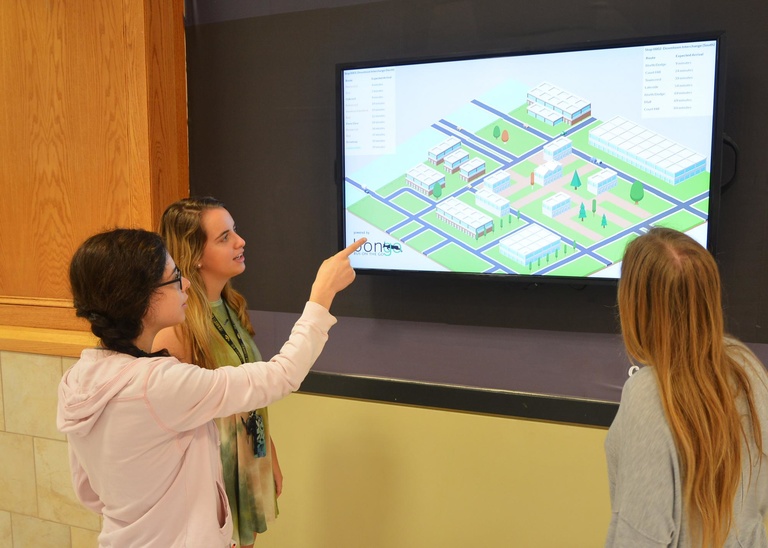As a marketing specialist for UI Housing and Dining, Amanda Bittorf manages 31 digital signs that serve as electronic billboards in UI residence halls. The signs provide key information for students—like bus arrival times, menus, emergency alerts, ads for student groups, weather, news, and events.

With the July 2015 opening of Petersen Residence Hall, home to 16 digital signs, Housing and Dining was one of the first customers to test and begin adopting a new digital signage solution based on Drupal, the predominate web content management system used for UI websites.
The Drupal Digital Signage Service was rolled out campuswide as part of the OneIT Web Hosting Project, one of 16 TIER efficiency initiatives in information technology. Expanding use of Drupal to digital signs saves time and money several ways, including convenience and ease of use.
“Overall, we’ve been extremely happy switching over to Drupal,” Bittorf says, noting that adding content is a much smoother process and that replacing paper fliers with signs has significantly reduced manual labor and paper usage. “The backend is incredibly user-friendly. It’s the same system our websites run on, and so very intuitive. The web-based platform allows us to update information and slides from anywhere and anytime.”
Enthusiasm for the new Drupal Digital Signage Service grew quickly; 32 colleges and divisions representing 70 units now use the free and user-friendly solution.
Because Drupal is open-source software, there are no licensing fees. Hardware costs are lower thanks to the project team's discovery that the signs could run on small, energy-efficient compute sticks. The sticks cost far less than PCs and can be maintained with existing device-management tools. Wireless connectivity eliminates the expense of data ports and cabling.
Developed in-house at the UI, the Drupal Digital Signage system uses a webpage instead of a specialized software application, so displaying content is as simple as plugging the URL of a sign into a browser. Users are granted permission to access specific signs and by utilizing templates and a drag-and-drop interface they can display content or widgets in various regions of the screen. That content can also be easily shared with other units.
“Other solutions met the UI’s digital signage needs in days past, but we needed a system that was free for areas to adopt and easier to use,” says Jessica Richardson, a senior IT support consultant and Drupal Digital Signage Service owner. “There are hundreds of digital signs on campus, and many of the people who are responsible for managing the content aren’t technical experts, so having a user-friendly tool is really important.”
The project originated in the College of Liberal Arts and Sciences, which had launched a Drupal signage service for its departments. CLAS shared the backend code for its version with Information Technology Services, which developed a solution that scaled as an enterprise service. For the OneIT project, the groups combined the best of both to create a service for the entire campus.
“In addition to the benefits of lower costs and ease of use, the signs are accessible to all screen-reading technologies,” says CLAS Web Services Director Mark Fullenkamp. “It also saves staff time. The system is easy to learn, so training time decreased and now users only need to enter news or events once into a familiar interface. The content goes to both their websites and digital signs; no double entry is necessary. Our early adopters have been very glad to use the system.”
In addition to CLAS, the team included staff from ITS Web Services, Enterprise Technology Management and Enterprise Client Management, and the Graduate College. They won an Improving our Workplace Award for ingenuity and collaborative effort.
The digital signage team continues to enhance the service—many widgets will be considered for addition. The team already added the capability to show video via YouTube, and to display bus arrival times, computer lab (ITC) availability, weather, news, events, and Hawk Alerts.